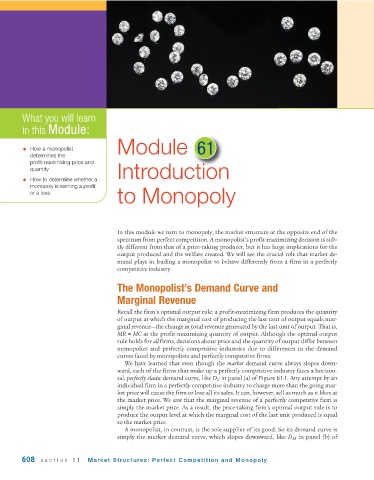Page 650 - Krugmans Economics for AP Text Book_Neat
P. 650
What you will learn
in this Module:
• How a monopolist Module 61
determines the
profit-maximizing price and
quantity Introduction
• How to determine whether a
monopoly is earning a profit
to Monopoly
or a loss
In this module we turn to monopoly, the market structure at the opposite end of the
spectrum from perfect competition. A monopolist’s profit-maximizing decision is sub-
tly different from that of a price-taking producer, but it has large implications for the
output produced and the welfare created. We will see the crucial role that market de-
mand plays in leading a monopolist to behave differently from a firm in a perfectly
competitive industry.
The Monopolist’s Demand Curve and
Marginal Revenue
Recall the firm’s optimal output rule: a profit-maximizing firm produces the quantity
of output at which the marginal cost of producing the last unit of output equals mar-
ginal revenue—the change in total revenue generated by the last unit of output. That is,
MR = MC at the profit-maximizing quantity of output. Although the optimal output
rule holds for all firms, decisions about price and the quantity of output differ between
monopolies and perfectly competitive industries due to differences in the demand
curves faced by monopolists and perfectly competitive firms.
We have learned that even though the market demand curve always slopes down-
ward, each of the firms that make up a perfectly competitive industry faces a horizon-
tal, perfectly elastic demand curve, like D C in panel (a) of Figure 61.1. Any attempt by an
individual firm in a perfectly competitive industry to charge more than the going mar-
ket price will cause the firm to lose all its sales. It can, however, sell as much as it likes at
the market price. We saw that the marginal revenue of a perfectly competitive firm is
simply the market price. As a result, the price-taking firm’s optimal output rule is to
produce the output level at which the marginal cost of the last unit produced is equal
to the market price.
A monopolist, in contrast, is the sole supplier of its good. So its demand curve is
simply the market demand curve, which slopes downward, like D M in panel (b) of
608 section 11 Market Structures: Perfect Competition and Monopoly

